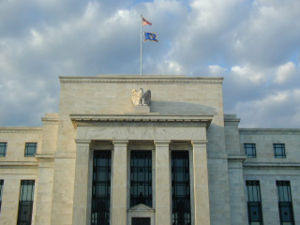Federal Reserve System: Difference between revisions
Jump to navigation
Jump to search

imported>Kjetil Ree |
imported>Kjetil Ree |
||
| Line 14: | Line 14: | ||
==References== | ==References== | ||
;Citations | |||
<div class="references-small" style="-moz-column-count:2; -webkit-column-count:2; column-count:2;"> | |||
<references /> | |||
</div> | |||
==Subtopics== | ==Subtopics== | ||
==Selected external links== | ==Selected external links== | ||
Revision as of 16:20, 26 June 2007

The Eccles building in Washington, D.C. is the headquarters of the Board of governors of the Federal Reserve
The Federal Reserve System is the central bank of The United States. It is also known as The Federal Reserve, or more informally as The Fed. The current chairman of the Board of Governors and the Federal Reserve's leader is Ben Bernanke.
Organization
The Federal Reserve is an independent agency of the United States federal government. Congress has a supervising role, but does not interfere on a daily basis. The chairman of the Federal Reserve is reporting to Congress biannually, but it is usually working closer with The Department of the Treasury and the president. Even though The Fed has an independent status, its independence might be revoked by Congress if Congress wishes to.[1]
History
The Federal Reserve Banks
What a Federal Reserve Bank does
References
- Citations
- ↑ Tucker, Irvin B (2006) Survey of Economics, page 358 Thomson South-Western, Mason, OH. ISBN 032431972